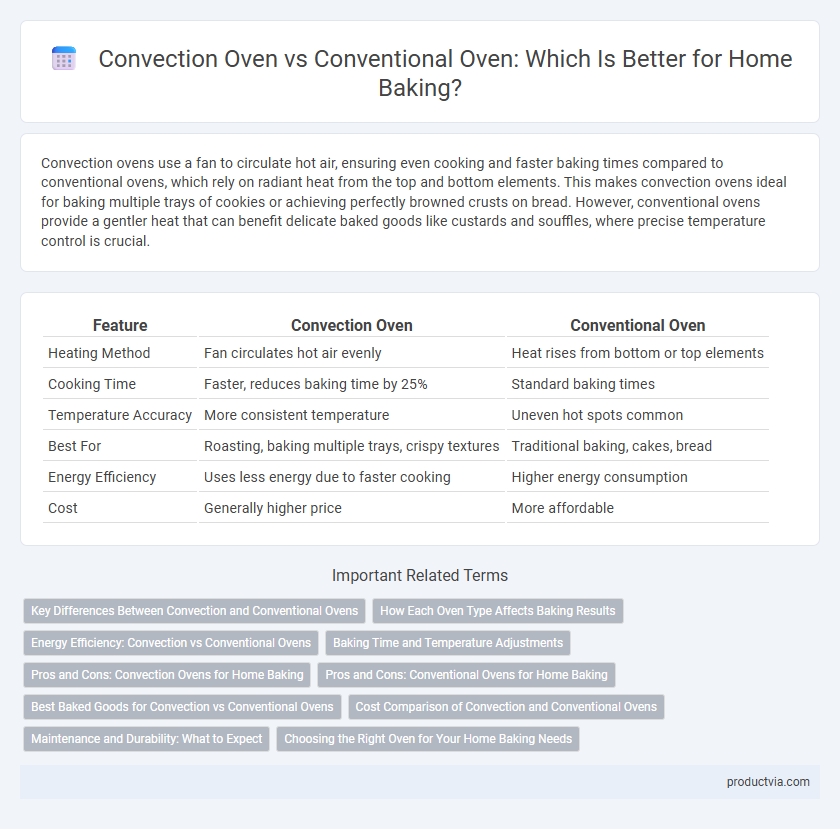Convection ovens use a fan to circulate hot air, ensuring even cooking and faster baking times compared to conventional ovens, which rely on radiant heat from the top and bottom elements. This makes convection ovens ideal for baking multiple trays of cookies or achieving perfectly browned crusts on bread. However, conventional ovens provide a gentler heat that can benefit delicate baked goods like custards and souffles, where precise temperature control is crucial.
Table of Comparison
| Feature | Convection Oven | Conventional Oven |
|---|---|---|
| Heating Method | Fan circulates hot air evenly | Heat rises from bottom or top elements |
| Cooking Time | Faster, reduces baking time by 25% | Standard baking times |
| Temperature Accuracy | More consistent temperature | Uneven hot spots common |
| Best For | Roasting, baking multiple trays, crispy textures | Traditional baking, cakes, bread |
| Energy Efficiency | Uses less energy due to faster cooking | Higher energy consumption |
| Cost | Generally higher price | More affordable |
Key Differences Between Convection and Conventional Ovens
Convection ovens circulate hot air with a fan and exhaust system, promoting even heat distribution and faster cooking times, while conventional ovens rely on radiant heat from the top and bottom elements, which can result in uneven baking and longer cooking durations. Convection ovens maintain consistent temperatures ideal for baking multiple trays simultaneously, whereas conventional ovens may require rotating dishes to avoid hot spots. Home bakers often prefer convection ovens for crispy crusts and uniform browning, while conventional ovens are favored for delicate recipes that require gentler, steady heat.
How Each Oven Type Affects Baking Results
Convection ovens circulate hot air with a built-in fan, promoting even heat distribution that results in faster cooking times, crispier textures, and more uniform browning for baked goods. Conventional ovens rely on radiant heat from elements at the top and bottom, which can cause uneven temperatures and hot spots, potentially leading to inconsistent rising or browning in cakes and breads. For home baking, convection ovens excel in achieving consistent results with pastries and cookies, while conventional ovens are often preferred for delicate souffles and custards that benefit from gentler, steady heat.
Energy Efficiency: Convection vs Conventional Ovens
Convection ovens use a fan to circulate hot air, resulting in faster and more even cooking, which reduces energy consumption compared to conventional ovens that rely on radiant heat. Energy efficiency in convection ovens can lead to savings of up to 20-30% in electricity or gas usage during home baking. Conventional ovens often require longer preheating and cooking times, making them less energy-efficient for baking tasks.
Baking Time and Temperature Adjustments
Convection ovens reduce baking time by circulating hot air evenly, allowing for lower temperature settings, typically 25degF (15degC) less than conventional ovens. Conventional ovens rely on radiant heat, often requiring longer baking times and consistent temperatures to ensure even cooking. Adjusting recipes by decreasing temperature and baking time in convection ovens prevents overbaking and achieves optimal results for home baking.
Pros and Cons: Convection Ovens for Home Baking
Convection ovens offer even heat distribution with a fan, resulting in faster cooking times and consistent browning, making them ideal for baking multiple trays simultaneously. However, they can dry out baked goods if not monitored closely, as the circulating air reduces moisture retention compared to conventional ovens. Home bakers may need to adjust temperature and timing settings to avoid over-baking and achieve optimal results.
Pros and Cons: Conventional Ovens for Home Baking
Conventional ovens offer consistent, radiant heat from the top and bottom, making them ideal for traditional baking tasks such as cakes and bread, but they often result in uneven cooking and hot spots. Their simpler design usually costs less and requires less maintenance compared to convection ovens, making them more accessible for home bakers. However, the lack of a fan means longer baking times and less efficient heat circulation, which can affect the texture and browning of baked goods.
Best Baked Goods for Convection vs Conventional Ovens
Convection ovens excel at baking items like cookies, pastries, and roasted vegetables, delivering even heat distribution and crisp, golden exteriors. Conventional ovens are ideal for delicate baked goods such as cakes, souffles, and custards, as their slower, gentler heat prevents over-browning and promotes consistent rising. Home bakers seeking optimal results should match their oven type to the specific texture and moisture characteristics desired in the final baked product.
Cost Comparison of Convection and Conventional Ovens
Convection ovens typically cost more upfront than conventional ovens due to their advanced fan and exhaust system that circulates hot air for even cooking. While conventional ovens are generally less expensive to purchase, convection ovens can reduce cooking times and energy consumption, potentially lowering long-term utility bills. Home bakers should weigh initial investment against energy efficiency and cooking performance to determine the best value for their needs.
Maintenance and Durability: What to Expect
Convection ovens typically require more regular maintenance due to the additional fan and exhaust systems, which need cleaning to ensure optimal airflow and performance. Conventional ovens have simpler designs with fewer components prone to malfunction, often resulting in greater long-term durability and lower maintenance costs. Home bakers should consider these factors to balance convenience with oven longevity for consistent baking results.
Choosing the Right Oven for Your Home Baking Needs
Convection ovens provide even heat distribution through a fan, resulting in faster and more uniform baking, ideal for pastries, cookies, and roasting. Conventional ovens use radiant heat from the top and bottom elements, offering a traditional baking environment preferred for recipes requiring slow, gentle cooking. Selecting the right oven depends on your baking style, recipe types, and desired cooking speed for optimal home baking results.
Convection oven vs Conventional oven for home baking Infographic

 productvia.com
productvia.com